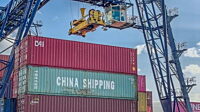Supply Chain Continuity Management (SCCM)
Supply chain continuity management (SCCM) refers to the strategic planning and management of measures to ensure the continuous functioning and efficiency of an organisation’s supply chain. The term is derived from the need to protect supply chains against various risks and potential disruptions that can be caused by factors such as natural disasters, political unrest, economic fluctuations or technological failures.
1.666 alarms per second
safeREACH as your powerful emergency notification system with up to 100.000 alarms per minute. Successfully used by multinational corporations, medium-sized companies and public authorities. ISO-certified server infrastructure.

SCCM involves identifying these risks, assessing their potential impact on the supply chain and developing strategies to mitigate risk and quickly restore the supply chain in the event of a disruption. This includes not only planning for short-term disruptions, but also the long-term adaptation of the supply chain to changing circumstances and market requirements.
Effective supply chain continuity management enables companies to
- Avoid supply bottlenecks
- Control costs
- Increase customer satisfaction
- and gain a competitive advantage
by maintaining a robust and responsive supply chain.

Areas of application of the SCCM
The field of application of SCCM is extensive and cross-industry. It plays a crucial role in industries where the supply chain is a critical factor for business success – this includes the automotive industry, pharmaceuticals, retail, electronics and many more. In these sectors, SCCM ensures that products and services are delivered on time and to the required quality despite unforeseen events.
Furthermore, SCCM is of particular importance in globalised markets, where complex, cross-border supply chains are susceptible to a variety of risks. In such cases, SCCM requires not only planning within an organisation, but also coordination with international suppliers, logistics service providers and customers. By implementing SCCM, companies can increase the efficiency of their supply chain, improve responsiveness to market changes and ensure compliance requirements are met.
Over 20 years of experience in alerting
IT alerting, fire alarms, alerting company first responders and much more. ISO-certified server infrastructure. Used by SMEs, corporations, authorities and public organisations.

Crisis management as an important part of supply chain continuity management
Crisis management is a central component of supply chain continuity management (SCCM) and is concerned with preparing for, dealing with and recovering from crises that could affect the supply chain. In contrast to risk management, which focuses on the prevention and mitigation of potential risks, crisis management refers to the active response to crisis situations that have already occurred or are imminent. This process includes the development and implementation of contingency plans, the rapid mobilisation of resources, effective communication with all stakeholders and adaptation to changing conditions during a crisis.
Crisis management in SCCM requires comprehensive planning that takes into account various scenarios, from sudden supply disruptions to prolonged outages. Organisations need to develop contingency plans that provide clear instructions on how to deal with different types of crisis. These plans should be regularly reviewed and updated to ensure their effectiveness.
1.666 alarms per second
safeREACH as your powerful emergency notification system with up to 100.000 alarms per minute. Successfully used by multinational corporations, medium-sized companies and public authorities. ISO-certified server infrastructure.

Fast response plays an important role
An important aspect of crisis management in SCCM is the ability to respond quickly to unforeseen events. This requires flexible supply chain structures, the ability to mobilise alternative sources of supply or transport methods quickly and robust communication networks to disseminate relevant information efficiently.
After a crisis has been managed, analysing the events and reactions is crucial in order to learn lessons for the future. Organisations should assess their performance during the crisis, identify weaknesses in their plans and make improvements to respond even more effectively in future crises. This continuous improvement is an essential part of crisis management in SCCM, as it helps to strengthen the resilience and stability of the supply chain in the long term.
What role do technologies such as AI, blockchain and IoT play?
In addition to the use of crisis management software such as safeREACH, technology is playing an increasingly important role in SCCM. Modern technologies such as artificial intelligence (AI), the Internet of Things (IoT) and blockchain offer new opportunities for monitoring and optimising the supply chain. For example, AI and machine learning can be used to predict and identify risks, while IoT devices enable real-time monitoring of the supply chain, from manufacture to delivery.
Blockchain technology can provide improved transparency and security in the supply chain by providing an immutable record of all transactions. These technologies enable companies to respond more flexibly to change, increase efficiency and develop innovative solutions to complex supply chain challenges. In the wake of digital transformation, the use of such technologies in SCCM is becoming increasingly important to remain competitive and ensure supply chain resilience in a rapidly changing business world.
Over 20 years of experience in alerting
IT alerting, fire alarms, alerting company first responders and much more. ISO-certified server infrastructure. Used by SMEs, corporations, authorities and public organisations.

SCCM stands for ‘Supply Chain Continuity Management’. It refers to a strategic management approach that focuses on maintaining, strengthening and restoring a company's supply chain.
The main objectives of SCCM are to ensure the continuous functionality, efficiency and resilience of a company's supply chain. This includes preparing for and managing risks and crises that could affect the supply chain, such as natural disasters, political unrest or technological failures. SCCM aims to minimise disruptions, enable rapid recovery from disruptions and adapt the supply chain to withstand long-term changes and challenges.
While traditional risk management focuses on identifying, assessing and mitigating risks in different areas of an organisation, SCCM is specifically focused on the supply chain. It includes not only risk management, but also the development of strategies to maintain and recover the supply chain in the event of a disruption. SCCM takes a holistic view of the supply chain and incorporates aspects such as supplier management, logistics, warehousing and customer relationships to ensure continuous operational readiness.